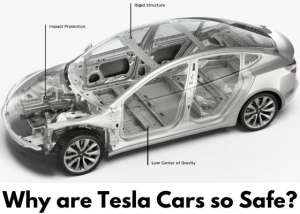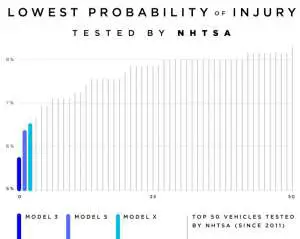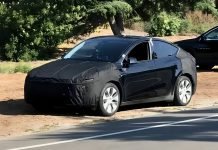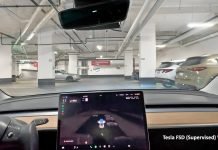Tesla has been holding its position being at the forefront of the long list of automaker companies. While other companies have been busy cashing their brand values making cars that focus in certain specific areas to cater to mass markets, Elon’s focus has been on the aspects that most companies don’t pay much attention to. Being a very new player in the automobile industry, Tesla has been excelling at making vehicles that are efficient, well connected, and jam-packed of innovative features and are coined as exceptionally safe. Tesla with its Model S claims to have achieved the best safety rating of any car tested. Lately the Tesla Model 3 shares the same claims of being known to have attained the lowest probability of injury of any vehicle tested by NTSA till date.

Why are Tesla Cars so Safe?
Tesla Vehicle Safety Report
On Tesla’s official website, it is stated that at Tesla, engineers design and execute every aspect of their vehicles treating safety as the topmost priority. The fundamental idea that technology can be used to improve safety makes them the safest car on the planet. If safety is a coin then passive safety and active safety are the two sides. These two are very well balanced in Tesla.

Another aspect is the automated driver assistance which is extremely crucial for keeping not just Tesla drivers and passengers safe, but all drivers and pedestrians on the road. It’s this belief that justifies every decision by the big wigs at Tesla to make the design of cars, to the software incorporated, to the features offered every Tesla owner act in sync.
Tesla Safety Rating
The U.S government’s New Car Assessment Program has rated the Model S, Model X and Model 3 with the lowest overall probability of injury of any vehicle ever tested. The credit for achieving this feat goes to the rigid, fortified structure of the battery pack mounted to the car’s floor, this design benefits the car in terms of safety as well with exceptional large crumple zones, strength, and a uniquely low centre of gravity. Being extra strong because of the mentioned design cues, Tesla’s battery packs rarely incur serious damage in accidents. It is extremely unlikely that a fire occurs in an accident because of the state-of-the-art design of battery packs. The safety system works by isolating a fire to specific areas within the battery and venting heat away from the passenger cabin and the vehicle.
It is inevitable for any vehicle to prevent all accidents from happening; it is yet possible to try to make them much less likely to occur. Since September 2014, Tesla has made Active Safety features as a standard offering on all its cars. These serve as an added layer of safety beyond the physical structure of each car. The good news being every Tesla is connected, which enables these systems to use the billions of miles of real-world data. This data collection is possible because more than 1 billion Tesla has been driven by Autopilot engaged to understand the different ways accidents happen. Using this data, various software is updated and features are added to help Tesla drivers mitigate or avoid accidents.
Tesla Safety Features
Tesla has been able to introduce safety features and enhancements to all its upcoming and existing fleet of cars that are running on roads, as well as release updated versions of existing safety features through over-the-air software updates. This way Tesla is capable of taking into account the most up-to-date real-world data collected by their fleet.
Another bold move by Tesla was to begin voluntarily release of their quarterly safety data to provide critical safety information about their vehicles to the public since October 2018. July 2019 marked the beginning of voluntarily releasing annually updated data about vehicle fires.
Features in terms of design and construction that make Tesla cars so safe and have enabled them to attain a 5-star safety rating in case of crashes:
- The Frontal Offset Test: being an all-electric car, the Tesla EVs don’t have an engine up front, instead all the empty steel and aluminum structure in the front serves as a crumple zone drawing the impact of the crash away from the passenger compartment.
- Roof Strength: the roof strength of a car determines the extent of passenger safety in a car in case of a rollover. When tested for the same the Tesla Model 3 resisted over 20000 pounds of force.
- The All-Electric Powertrain Design: The rollover ratings of the Tesla Model 3 are significantly improved because of the focal point of the large battery inside the foot of the car that comprises a big part of the All-Electric Powertrain Design. This enables the car to return to its upright position preventing any rollover to extreme extents.
- Airbags, Strains, and Seat Geometry contribute to a higher occupant protection score. The front passenger airbags are very uniquely shaped and all the airbags are thick curtain which provides more than satisfactory level of protection in case of a crash.
Having discussed briefly passive safety features, now let us jump to active safety features in the Tesla vehicles which help in avoiding accidents in the first place.
- Automatic Emergency Braking System: This feature self brakes the car in case of any obstruction like a stopped vehicle in front of a pedestrian or a cyclist. The IIHS gave a superior rating for the same whereas the EuroNCap gave a 94% score in the assist category.
- The Lane Assist System: Model 3, when crossing the white line denoting the edge of its lane towards an oncoming vehicle, the system acts by redirecting the car into the right lane preventing any collision.
Tesla cars are among the safest in all categories
NHTSA has awarded the Tesla Model S and Tesla Model X a 5-star safety rating in every subcategory of the crash tests which is the maximum a car can score in NHTSA’s tests. They have surpassed all other cars in their categories with their results in the pole tests and rollover risks are exceptional being many times better than their next safest counterparts. They have excelled in Euro NCAP’s tests as well. In another test by IIHS Tesla Model 3 also received a ‘superior rating for front crash prevention’ and maximum points too.
Although these testing agencies have also pointed out a few flaws, the Institute for Highway Safety (IIHS) has criticized the Model S for its poor headlights and only adequate protection in small overlap accidents. It also condemned the Model 3 for its poor braking, which is comparable to that of a full-sized pickup truck. Musk then promised a software update that would fix these issues.
Tesla Car Fire Statistics
Statistics show that more than 174,000 vehicles catch fire every year in the U.S, this equates up to a vehicle fire once every three minutes. Due to the kind of technology used in Electric cars, it makes them more prone to vehicle fires. Surprisingly out of more than 300,000 Tesla vehicles on the roads, only 40 fires have happened having crossed 7.5 billion miles travelled which means only 5 fires for every billion miles. When compared to its internal combustion counterparts it is 11 times less. Although it is to be kept in mind that in case of a crash involving an electric car, because the chemical composition of the batteries, it may lead to a fire that’s much more difficult to extinguish than in the case of an internal combustion car. But this doesn’t mean that a crash in a Tesla would automatically lead to a fire.
Tesla Autopilot Accident Rate
The `Autopilot` name is often misinterpreted
Tesla has always stated that the Autopilot is an assist feature and the driver has to be attentive at all times. This is where the drivers misjudge the capabilities of the Autopilot feature. Often Tesla drivers use the Autopilot relying on them blindly ignoring what its Autopilot is and isn’t capable of doing. But the fact is that the name `Autopilot` is misinterpreted by the drivers. Most of the fatal crashes involving Tesla vehicles with the Autopilot engaged happened because drivers rely too much on the self-driving capabilities of the vehicle which are still far away from 100% autonomous driving.
Are Tesla cars on Autopilot more dangerous than ones driven by people?
The statistics by the National Safety Council (NSC) estimate 40,100 deaths as a result of car accidents in 2017, a 1% plunge from the preceding year. The fact to be noticed is that only three of these happened in cars on Autopilot. In an apple to apple comparison, the problem with Tesla cars is that they still covered too few miles as compared to internal combustion cars to reach a conclusive decision.
According to an NHTSA study from 2016, Tesla cars with the Autopilot mode installed were involved in 0.8 crashes per million miles which is comparably lower than 1.3 crashes per million in cars which didn’t have Autopilot. This is a 40% reduction in crashes. When counting deaths, Tesla states that it has observed 1 fatality for every 320 million miles driven, compared with 1 for every 86 million miles driven for vehicles of all manufacturers.
Reports of the latest crash involving deadly crashes with Tesla on Autopilot involving a truck or a stationary object, presumably these things are difficult to assess by current self-driving systems. Statistically, this is a very small number to use for making any sort of claims. Therefore it is not yet the right time to say if Tesla’s Autopilot is safer or unsafe than a human-driven car. At least a billion miles were driven and several years worth of data have to be accumulated to make any fair claim.
The main purpose of the Autopilot system’s design is to follow speed limits and traffic regulations theoretically, making them safer than human-driven cars, especially when used properly. The truth is, even counting data from all other autonomous cars in the equation; we still don’t have sufficient information to settle the dispute.
Final Words
If you drive your Tesla, in the end, it’s up to you how safe you’d be. The conclusion to be drawn is that the use of Tesla as any normal driver would, you still are in one of the safest cars. Its extraordinary crash-test ratings harmonize with real-life stories in which Teslas crashed, yet their passengers survived.
At the same time, while using Autopilot, Tesla’s warnings should be kept in mind and hands on the wheel and your eyes on the road. It’s better to use Tesla’s advanced driver alerting functions at high speeds and the Autopilot drive only in highway traffic jams, and never use the Autopilot on local roads.


















